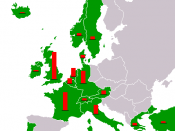In June of 1947 the US Secretary of State George Marshall outlined to the world a detailed plan to provide extensive financial aid to the countries of Europe; this soon became known as the Marshall plan. Today many consider the Marshall plan to be the most successful undertaking the US has ever embarked upon, like who? In what context? I don't like this way of writing because one could argue that dental care for children under 10 is more successful. yet despite this there are those who bring into question the true motive behind it. Whether or not there were hidden agendas present, the main of which highlighted as "American Imperialism", is indeed a query brought to light on many an occasion. There are factors present on both sides of this argument of equal magnitude which complicate matters greatly, shying away from basic black and white interpretation.
Whether or not there were hidden agendas attached to the Marshall Plan, the aid it supplied was absolutely crucial for the wellbeing of the countries on the receiving end as it was given as US Dollars, and according to post-revisionist historian Professor David Painter, it was US Dollars the countries needed most.
YES! Before the WWII Western Europe received most of its fuel, coal and food from Eastern Europe, and manufactured goods from Germany. However now that the war was over, Eastern Europe was under Soviet influence and Germany was in a state of chaos, both incapable of adequate trade with their western neighbours. This led Western Europe to turn to the most organized and able potential trade associate it could see, the United States. Despite the visible availability of resources the US was ready to sell, the cost of it all was paralysing to even think of as Western Europe's economy was suffering as a direct consequence of the war. Throughout 1947, Western Europe's agricultural production was 83% of its pre-war volume, industrial production 88%, and exports a meagre 59%. %. In fact, Western Europe's economic state was so bad that Britain had to with draw forces from Greece and Turkey, countries of crucial strategic location at risk of being invaded by the Soviet Union. Furthermore any trade with the US meant possession of a substantial amount of US Dollars was vital, a quality not particularly enjoyed by Western Europe. So in that sense, for any restoration and growth to occur in Western Europe US Dollars were needed, which is exactly where the Marshall plan came in.
There are many aspects of the situation which portray the United States to be acting out of generosity more so than opportunity for self-gain. The characteristics of the plan itself, when placed in contrast with the likes of aid given today, are themselves a key feature of this side of the argument. An important example of this is the fact that 90% of the Marshall Plan aid was given to Western Europe in the form of grants, and not loans. This is important because it meant that all recipients of Marshall Plan aid would not automatically go into debt as a direct result, which is usually common practice in any foreign aid, such as the Dawes plan of 1924 and Young Plan of 1929 which supplied Loans to Weimar Germany. As a direct result of the loans, Germany was shaken to the core by America's Stock Market crash of October 1929. The US remembered this and recognised how economic devastation led to the rise of radicalism. George Marshall himself stated upon his return from visiting Europe that it had become a "breeding ground of hatred", and as a direct response formulated the Marshall Plan.
Another key characteristic of the plan which showcased the generous side of the United States was its policy of European integration within its own rehabilitation. An example of this was the creation of the Organisation for European Economic Cooperation (OEEC), which consisted of a representative from each country and dealt with issues such as, but not limited to, devising annual recovery plans and allocating American aid. Each participating government also set up its own recovery agency within the OEEC . This too is a very important aspect of the Marshall Plan, as incorporation of a country into its own recovery plan enhances its capabilities of coping in the long run when whichever country or organisation which was helping it out has left. Thus it can be seen that there was indeed a certain degree of generosity behind the US incentive for the Marshall Plan.
However, there too are many aspects of the situation which give off the impression that the Marshall Plan was based around United States "Dollar Imperialism".
One such aspect is how the United States gave itself the liberty of having influence over how the aid was used once in the hands of the recipients. For example, instead of revitalising Germany as a producer of manufactured goods, its main source of income before the war, aid was strictly pumped into establishing raw materials as Germany's chief export. In 1932, a good seven years before the outbreak of WWII, 67% of its imports were raw materials, whereas in 1948 this figure dropped to only 17%. The fact that the US's chief export was that of manufactured goods is surely no coincidence. It not only deliberately forced Germany out of that area of the economy, most likely to eliminate any threats to best wishes of the American economy, but it also forced Germany to increase the amount of money spent on manufactured goods, and with America's influence it's not too hard to guess where they were 'advised' to make most of their purchases. This is blatant market domination, not quite something one would assume to be on the minds of people committing, as proclaimed by Winston Churchill, the "most unsordid act in human history." This aspect alone brings a strong point to the table regarding the US's possible imperialistic intentions behind the Marshall Plan.
So it can be seen that indeed there are various different ways of looking at the Marshall Plan, each with its own specific explanation concerning the true motivation behind it. As with any historical event of certain magnitude, interpretation is vital to identification of key attributes resulting in what can usually be separated into two basic opposing sides, a simplistic black and white picture. The Marshall Plan is definitely an interesting example, as to a certain extent both sides may very well have been true. It is perfectly understandable for the United States to have wanted a certain degree of gain from the project, as 13 billion dollars is an incredibly large sum of money, and as the countries receiving aid would benefit nonetheless, it would be a win/win situation. In conclusion it can be stated that both sides of the argument stand their ground with definite vigour, and that in the long run, should current events snatch from us the light of day, greyscale has prevailed.


